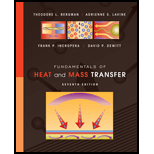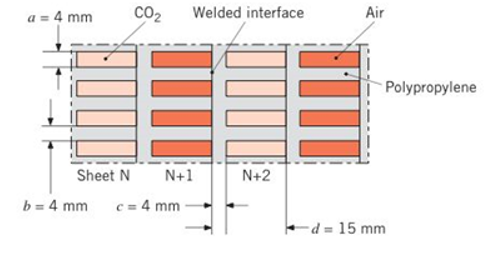
Concept explainers
A novel heat exchanger concept consists of a largenumber of extruded polypropylene sheets

Want to see the full answer?
Check out a sample textbook solution
Chapter 11 Solutions
Fundamentals of Heat and Mass Transfer
Additional Engineering Textbook Solutions
Thermodynamics: An Engineering Approach
Statics and Mechanics of Materials (5th Edition)
Fluid Mechanics Fundamentals And Applications
Automotive Technology: Principles, Diagnosis, and Service (5th Edition)
Engineering Mechanics: Statics
Vector Mechanics For Engineers
- Water flowing in a long, aluminum lube is to be heated by air flowing perpendicular to the exterior of the tube. The ID of the tube is 1.85 cm, and its OD is 2.3 cm. The mass flow rate of the water through the tube is 0.65kg/s, and the temperature of the water in the lube averages 30C. The free-stream velocity and ambient temperature of the air are 10m/sand120C, respectively. Estimate the overall heat transfer coefficient for the heat exchanger using appropriate correlations from previous chapters. State all your assumptions.arrow_forwardSaturated steam at 110°C is condensed in a shell-and-tube heat exchanger (1 shell pass; 2, 4, ⋯ tube passes) with a UA value of 2.5 kW/K. Cooling water enters at 40°C. (a) Calculate the cooling water flow rate required to maintain a heat rate of 150 kW. (b) Assuming that UA is independent of flow rate, calculate and plot the water flow rate required to provide heat rates over the range from 130 to 160 kW. Comment on the validity of your assumption.arrow_forwardWater is used in a heat exchanger to cool 5 kg/s of air from 400°C to 200°C. Calculate: A. The mass flow of water; B. The heat transfer rate to the water. 20°C WATER AIR AIR Heat Exchanger 400°C 200°C - 30°C WATERarrow_forward
 Principles of Heat Transfer (Activate Learning wi...Mechanical EngineeringISBN:9781305387102Author:Kreith, Frank; Manglik, Raj M.Publisher:Cengage Learning
Principles of Heat Transfer (Activate Learning wi...Mechanical EngineeringISBN:9781305387102Author:Kreith, Frank; Manglik, Raj M.Publisher:Cengage Learning
